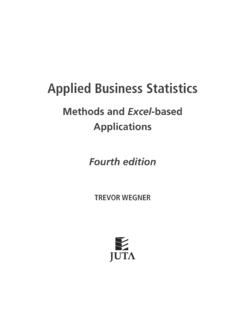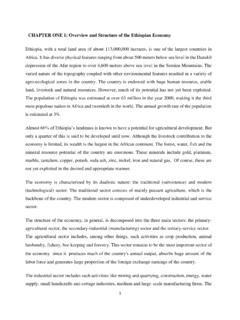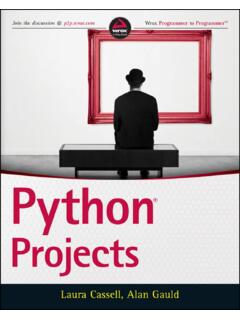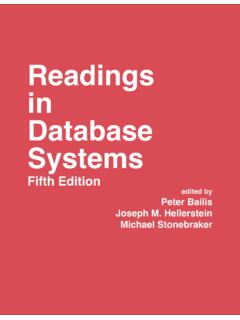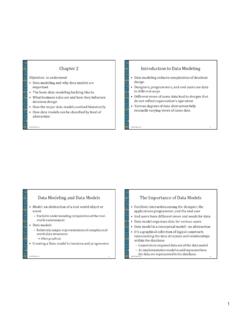Transcription of FUNDAMENTALS OF Database Systems
1 FUNDAMENTALS OFDatabaseSystemsSIXTH EDITIONThis page intentionally left blank FUNDAMENTALS OFDatabaseSystemsSIXTH EDITIONR amez ElmasriDepartment of Computer Science and EngineeringThe University of Texas at ArlingtonShamkant B. NavatheCollege of ComputingGeorgia Institute of TechnologyAddison-WesleyBoston Columbus Indianapolis New York San Francisco Upper Saddle River Amsterdam Cape Town Dubai London Madrid Milan Munich Paris Montreal Toronto Delhi Mexico City Sao Paulo Sydney Hong Kong Seoul Singapore Taipei TokyoEditor in Chief:Michael HirschAcquisitions Editor:Matt GoldsteinEditorial Assistant:Chelsea BellManaging Editor:Jeffrey HolcombSenior Production Project Manager:Marilyn LloydMedia Producer:Katelyn BollerDirector of Marketing:Margaret WaplesMarketing Coordinator:Kathryn Ferranti Senior Manufacturing Buyer:Alan FischerSenior Media Buyer:Ginny MichaudText Designer:Sandra Rigney and Gillian HallCover Designer:Elena SidorovaCover Image:Lou Gibbs/Getty ImagesFull Service Vendor:Gillian Hall, The Aardvark GroupCopyeditor:Rebecca GreenbergProofreader:Holly McLean-AldisIndexer:Jack LewisPrinter/Binder:Courier, WestfordCover Printer.
2 Lehigh-Phoenix Color/HagerstownCredits and acknowledgments borrowed from other sources and reproduced with permis-sion in this textbook appear on appropriate page within interior of this book was set in Minion and Akzidenz 2011, 2007, 2004, 2000, 1994, and 1989 Pearson Education, Inc., publishing asAddison-Wesley. All rights reserved. Manufactured in the United States of America. Thispublication is protected by Copyright, and permission should be obtained from the publisherprior to any prohibited reproduction, storage in a retrieval system, or transmission in anyform or by any means, electronic, mechanical, photocopying, recording, or likewise. Toobtain permission(s) to use material from this work, please submit a written request to Pear-son Education, Inc., Permissions Department, 501 Boylston Street, Suite 900, Boston, Massa-chusetts of the designations by manufacturers and sellers to distinguish their products areclaimed as trademarks.
3 Where those designations appear in this book, and the publisher wasaware of a trademark claim, the designations have been printed in initial caps or all of Congress Cataloging-in-Publication DataElmasri, of Database Systems / Ramez Elmasri, Shamkant B. Navathe. 6th bibliographical references and : 978-0-136-08620-81. Database management. I. Navathe, Sham. II. dc22 Addison-Wesleyis an imprint of10 9 8 7 6 5 4 3 2 1 CW 14 13 12 11 10 ISBN 10: 0-136-08620-9 ISBN 13: 978-0-136-08620-8To Katrina, Thomas, and Dora(and also to Ficky)R. my wife Aruna, mother Vijaya,and to my entire familyfor their love and page intentionally left blank viiThis book introduces the fundamental concepts nec-essary for designing, using, and implementingdatabase Systems and Database applications. Our presentation stresses the funda-mentals of Database modeling and design, the languages and models provided bythe Database management Systems , and Database system implementation tech-niques.
4 The book is meant to be used as a textbook for a one- or two-semestercourse in Database Systems at the junior, senior, or graduate level, and as a referencebook. Our goal is to provide an in-depth and up-to-date presentation of the mostimportant aspects of Database Systems and applications, and related assume that readers are familiar with elementary programming and data-structuring concepts and that they have had some exposure to the basics of com-puter to This Edition The following key features have been added in the sixth edition: A reorganization of the chapter ordering to allow instructors to start withprojects and laboratory exercises very early in the course The material on SQL, the relational Database standard, has been moved earlyin the book to Chapters 4 and 5 to allow instructors to focus on this impor-tant topic at the beginning of a course The material on object-relational and object-oriented databases has beenupdated to conform to the latest SQL and ODMG standards, and consoli-dated into a single chapter (Chapter 11) The presentation of XML has been expanded and updated, and moved ear-lier in the book to Chapter 12 The chapters on normalization theory have been reorganized so that the firstchapter (Chapter 15) focuses on intuitive normalization concepts, while thesecond chapter (Chapter 16)
5 Focuses on the formal theories and normaliza-tion algorithms The presentation of Database security threats has been updated with a dis-cussion on SQL injection attacks and prevention techniques in Chapter 24,and an overview of label-based security with examplesPreface Our presentation on spatial databases and multimedia databases has beenexpanded and updated in Chapter 26 A new Chapter 27 on information retrieval techniques has been added,which discusses models and techniques for retrieval, querying, browsing,and indexing of information from Web documents; we present the typicalprocessing steps in an information retrieval system, the evaluation metrics,and how information retrieval techniques are related to databases and toWeb searchThe following are key features of the book: A self-contained, flexible organization that can be tailored to individualneeds A Companion Website ( ) includes data to beloaded into various types of relational databases for more realistic studentlaboratory exercises A simple relational algebra and calculus interpreter A collection of supplements, including a robust set of materials for instruc-tors and students, such as PowerPoint slides, figures from the text, and aninstructor s guide with solutionsOrganization of the Sixth EditionThere are significant organizational changes in the sixth edition, as well as improve-ment to the individual chapters.
6 The book is now divided into eleven parts as follows: Part 1 (Chapters 1 and 2) includes the introductory chapters The presentation on relational databases and SQL has been moved to Part 2(Chapters 3 through 6) of the book; Chapter 3 presents the formal relationalmodel and relational Database constraints; the material on SQL (Chapters 4and 5) is now presented before our presentation on relational algebra and cal-culus in Chapter 6 to allow instructors to start SQL projects early in a courseif they wish (this reordering is also based on a study that suggests studentsmaster SQL better when it is taught before the formal relational languages) The presentation on entity-relationship modeling and Database design isnow in Part 3 (Chapters 7 through 10), but it can still be covered before Part2 if the focus of a course is on Database design Part 4 covers the updated material on object-relational and object-orienteddatabases (Chapter 11) and XML (Chapter 12) Part 5 includes the chapters on Database programming techniques (Chapter13) and Web Database programming using PHP (Chapter 14, which wasmoved earlier in the book) Part 6 (Chapters 15 and 16)
7 Are the normalization and design theory chapters(we moved all the formal aspects of normalization algorithms to Chapter 16)viiiPrefacePrefaceix Part 7 (Chapters 17 and 18) contains the chapters on file organizations,indexing, and hashing Part 8 includes the chapters on query processing and optimization tech-niques (Chapter 19) and Database tuning (Chapter 20) Part 9 includes Chapter 21 on transaction processing concepts; Chapter 22on concurrency control; and Chapter 23 on Database recovery from failures Part 10 on additional Database topics includes Chapter 24 on Database secu-rity and Chapter 25 on distributed databases Part 11 on advanced Database models and applications includes Chapter 26on advanced data models (active, temporal, spatial, multimedia, and deduc-tive databases); the new Chapter 27 on information retrieval and Websearch; and the chapters on data mining (Chapter 28) and data warehousing(Chapter 29)Contents of the Sixth EditionPart 1 describes the basic introductory concepts necessary for a good understandingof Database models, Systems , and languages.
8 Chapters 1 and 2 introduce databases,typical users, and DBMS concepts, terminology, and 2 describes the relational data model, the SQL standard, and the formal rela-tional languages. Chapter 3 describes the basic relational model, its integrity con-straints, and update operations. Chapter 4 describes some of the basic parts of theSQL standard for relational databases, including data definition, data modificationoperations, and simple SQL queries. Chapter 5 presents more complex SQL queries,as well as the SQL concepts of triggers, assertions, views, and schema 6 describes the operations of the relational algebra and introduces the rela-tional 3 covers several topics related to conceptual Database modeling and databasedesign. In Chapter 7, the concepts of the Entity-Relationship (ER) model and ERdiagrams are presented and used to illustrate conceptual Database design. Chapter 8focuses on data abstraction and semantic data modeling concepts and shows howthe ER model can be extended to incorporate these ideas, leading to the enhanced-ER (EER) data model and EER diagrams.
9 The concepts presented in Chapter 8include subclasses, specialization, generalization, and union types (categories). Thenotation for the class diagrams of UML is also introduced in Chapters 7 and 9 discusses relational Database design using ER- and EER-to-relationalmapping. We end Part 3 with Chapter 10, which presents an overview of the differ-ent phases of the Database design process in enterprises for medium-sized and largedatabase 4 covers the object-oriented, object-relational, and XML data models, and theiraffiliated languages and standards. Chapter 11 first introduces the concepts forobject databases, and then shows how they have been incorporated into the SQLstandard in order to add object capabilities to relational Database Systems . It thenxPrefacecovers the ODMG object model standard, and its object definition and query lan-guages. Chapter 12 covers the XML (eXtensible Markup language ) model and lan-guages, and discusses how XML is related to Database Systems .
10 It presents XMLconcepts and languages, and compares the XML model to traditional databasemodels. We also show how data can be converted between the XML and 5 is on Database programming techniques. Chapter 13 covers SQL program-ming topics, such as embedded SQL, dynamic SQL, ODBC, SQLJ, JDBC, andSQL/CLI. Chapter 14 introduces Web Database programming, using the PHP script-ing language in our 6 covers normalization theory. Chapters 15 and 16 cover the formalisms, theo-ries, and algorithms developed for relational Database design by normalization. Thismaterial includes functional and other types of dependencies and normal forms ofrelations. Step-by-step intuitive normalization is presented in Chapter 15, whichalso defines multivalued and join dependencies. Relational design algorithms basedon normalization, along with the theoretical materials that the algorithms are basedon, are presented in Chapter 7 describes the physical file structures and access methods used in Database sys-tems.



